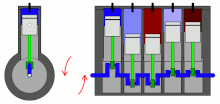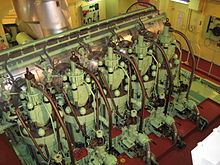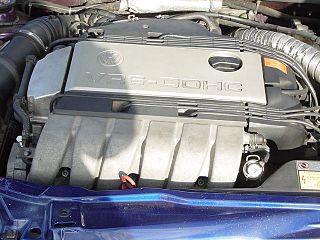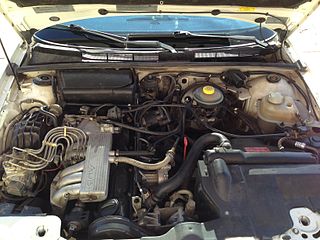Characteristics


Straight-five engines are typically shorter than straight-six engines, making them easier to fit transversely in an engine bay. [1] They are also smoother than straight-four engines, [1] and are narrower than V engines [2] and flat engines.
Engine balance and vibration
Five-cylinder engines have a crankshaft with 72 degree angles. [3] Amongst four-stroke engines, an advantage of engines with five or more cylinders is that the power strokes are overlapping if the engine has an even firing order. [1]
A disadvantage of the odd number of cylinders in a straight-five engine is it results in imperfect primary and secondary engine balance, unlike a straight-six engine which has perfect primary and secondary balance. Counterweights on the crankshaft can be used to counteract some amount of these vibrations. This method is also used in straight-four engines. [4] [5]
Firing order
Most four-stroke straight-five engines use a firing order of 1-2-4-5-3.[ citation needed ] This firing order results in the minimal primary (crank speed) rocking couple, and is used by the Volvo Modular engine, VW/Audi straight-five engine, General Motors Atlas engine and Honda G engine. Straight-five engines typically have a 72 degree crankshaft design. [3]
All two stroke straight-five engines are limited in having a single firing order for a given crank configuration; because a complete cycle occurs every 360 degrees, there is no chance to share piston phases without having simultaneous ignitions, so the straight-five is at no disadvantage in this case. Some two-stroke outboard engines, e.g. the Mercury Marine Force 150 engine use a firing order of 1-5-2-3-4. [6]
Carburettors and fuel injection
The use of straight-five petrol engines in mass production cars only became truly viable with the advent of reliable fuel injection. This is because of the unavoidable problems of a carburettor supplying an odd number of cylinders and the length of the inlet manifold between the carburetor varying greatly between cylinders at the ends of the engine and those nearer the carburetor. Unlike other engine layouts, these problems are not easily solved by using multiple carburettors.
Diesel engines have always used fuel injection, therefore large displacement straight-five diesel engines were commonly seen decades before straight-five petrol engines.














